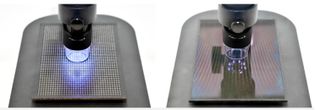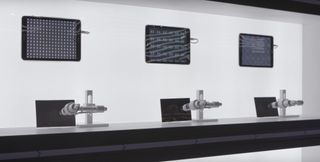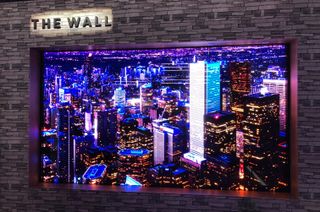What Is MicroLED and When Can You Get It?
MicroLED is poised to overtake OLED as the ultimate display technology. Here's how it works and when you can get your hands on it.
In the world of screen technology, MicroLED has quickly become the next big thing. Samsung has already showcased The Wall, a new MicroLED-based TV that spans a whopping 146 inches. And Apple is reportedly investing in MicroLED tech for its devices, including the Apple Watch and possibly the iPhone.

In a conversation about MicroLED with Tom's Guide at CES this year, Andrew Sivori, Samsung Electronics America vice president, called MicroLED "groundbreaking." He added that MicroLED is the first "new TV technology in almost 10 years."
But what is MicroLED, how does it stack up to OLED and when will products based on this tech hit shelves? We'll answer those questions and more in this guide.
What Is MicroLED?
To understand MicroLED, you first need to understand backlighting.
One of the reasons LCDs are considered old and not as desirable today is because they require a backlight in order to work. That backlight creates a more chunky product design, for one, but it can also create uneven brightness, color challenges and other problems.

OLEDs, however, are self-emissive, which means they can create their own light. That means they can deliver perfect blacks, outstanding color and allow for product designers to create exceptionally thin — and good-looking — devices. However, OLEDs are built with organic compounds that, over time, start to die off, potentially making them a problem over the long term.
MicroLED is designed to take everything that's great about OLEDs — the self-emissive technology, the perfect blacks and the outstanding colors — while ditching the organic compounds. That translates to MicroLED panels being exceedingly thin and capable of delivering outstanding viewing angles. And because they don't rely on organic compounds, MicroLED panels should be cheaper to produce than OLED. Best of all, MicroLED can technically deliver a brighter picture than OLEDs.
How does MicroLED work, and where will you find it?
According to Ray Soneira, president of DisplayMate Technologies, MicroLED has "been under development for years." He added that the technology was initially designed for "“small displays like watches and smartphones," but Samsung's idea of bringing it to televisions looks to be a sound one.

"TV is a great application for MicroLEDs because of its much lower pixel density, typically under 100 pixels per inch," Soneira said. Lower pixel density means manufacturers wouldn’t need to pack as many sub-pixels into the screen. The lower the pixel density, the easier it is to manufacture a MicroLED set.
But while MicroLED could technically come to any screen in the future, it's not exactly easy to produce.
MORE: QLED vs OLED TV: Who Wins?
"MicroLEDs are literally tiny LEDs that are made one at a time, and then packed and assembled into a display using robots that pick and place them one at a time, first into smaller substrates, and then the substrates are assembled onto the final display," Soneira said. One of the biggest challenges with MicroLEDs is that all of those tiny LEDs need to be calibrated to deliver the same brightness and have the same color controls. This is something Soneira calls a "major challenge."
Just how big of a challenge? According to Soneira, a single 4K television has 25 million of those small subpixels that then need to be assembled together and calibrated. One false step, and the MicroLED display won't deliver the best picture.
What are MicroLED's advantages?
At first blush, you might not find too many major unique features in MicroLEDs. After all, they allow for many of the same benefits as OLED.
However, according to Soneira, one of MicroLED's chief advantages is that it's exceedingly power-efficient. He noted that each MicroLED subpixel "can be manufactured with an individual parabolic mirror behind the LED that reflects all of the light toward the viewer." The mirror creates what he calls a "very high brightness power efficiency" that will ultimately improve battery life in devices like smartphones, smartwatches and laptops that all rely on a battery for power.
MORE: Apple's MicroLED Breakthrough Puts Samsung on Notice
And since MicroLED relies on LEDs for its light source, MicroLEDs are generally much brighter than any other display technology. That extremely high brightness could ultimately allow for better-looking pictures than even OLEDs, which have been called "perfect" by some display experts.
How does MicroLED compare to OLED?
MicroLED and OLED have their fair share of advantages and disadvantages, which could ultimately translate to some companies deciding to stick with OLED and others opting for MicroLED.
Manufacturing is arguably the most important OLED advantage. According to Soneira, manufacturers can produce a single OLED display packed with millions of subpixels in one fell swoop. The result is an outstanding picture with an infinite contrast ratio, perfect blacks and fantastic viewing angles. Best of all, OLEDs can offer extremely bright screens.

Meanwhile, manufacturing a MicroLED with one subpixel produced at a time is extremely challenging. And not even today's latest and greatest robot manufacturing technology is making that process simpler, according to Soneira. Until companies can overcome that challenge, OLED has a clear advantage.
Still, once a MicroLED display is manufactured, the result tells a different story.
Soneira told Tom's Guide in an interview that OLED's reliance on organic compounds ultimately results "in a decrease in luminance over time." Worse yet, as the OLED screen ages, there's a chance that some compounds will lose luminance more quickly than others, creating an uneven picture.
MORE: The best TVs right now
The LEDs in MicroLED, however, are not only brighter, but also won't lose their luster over time due to natural aging. Over the long term, then, MicroLEDs should be capable of keeping their picture quality and maintaining brightness, while OLEDs produced at the same time start to fade.
Additionally, MicroLEDs are far more power-efficient than OLEDs because of the aforementioned mirroring effect manufacturers employ.
Last but not least, MicroLEDs are technically capable of being produced at even thinner sizes than OLEDs, which could give product designers more control over their designs. This could include screens that curve or even fold.
When all is said and done, however, a clear winner might not be so easy to crown. OLEDs and MicroLEDs will deliver largely similar pictures in the short term, with MicroLEDs offering a brighter picture.
What are Apple and Samsung doing with MicroLED?
Let's start with Apple. In 2014, Apple acquired what many industry watchers viewed as the MicroLED industry leader, LuxVue. At the time, it was believed that Apple would use LuxVue's head start to develop MicroLED displays for its iPhone and Apple Watch, among other products.
Since then, Apple has kept a lid on what it's up to with MicroLED.
In March, however, Bloomberg reported that Apple had quietly amassed a large team of display professionals at a nondescript building in California. In that building, Apple employees are reportedly developing MicroLED screens in the hope of making displays in future products thinner, brighter and more power-efficient.
Still, the work is far from complete. And according to the Bloomberg report, Apple likely won't have MicroLED screens ready for prime time for another few years.
MORE: Best Smartphones - Here Are the 10 Best Phones Available
Unlike Apple, Samsung is already trumpeting its advances in MicroLED. At CES this year, the company unveiled The Wall display, which measures 146 inches and offers 4K resolution. Better yet, it features a modular design of several 4-inch-size panels, which suggests that users may be able to change the size of this MicroLED set.

We got up close with The Wall at a Samsung event in March and were impressed by its brilliant colors. The Wall TV is available to buy now, provided you have the money to pay for it.
When will I be able to get MicroLED in my iPhone or Galaxy phone?
This is one of the hardest questions to answer. Apple has remained silent on any plans, and Samsung has discussed only MicroLED TVs thus far.
Soneira believes we have some waiting to do. He says that it will "take at least three years to improve the display performance of MicroLEDs so that it matches OLEDs." In fact, Soneira says it could take "several more years to ramp up high volume production" so robots and manufacturing companies can actually build MicroLEDs in a cost-effective manner.
"OLED will remain dominant for at least another five years," Soneira said.
Sign up to get the BEST of Tom’s Guide direct to your inbox.
Upgrade your life with a daily dose of the biggest tech news, lifestyle hacks and our curated analysis. Be the first to know about cutting-edge gadgets and the hottest deals.
Don Reisinger is CEO and founder of D2 Tech Agency. A communications strategist, consultant, and copywriter, Don has also written for many leading technology and business publications including CNET, Fortune Magazine, The New York Times, Forbes, Computerworld, Digital Trends, TechCrunch and Slashgear. He has also written for Tom's Guide for many years, contributing hundreds of articles on everything from phones to games to streaming and smart home.
